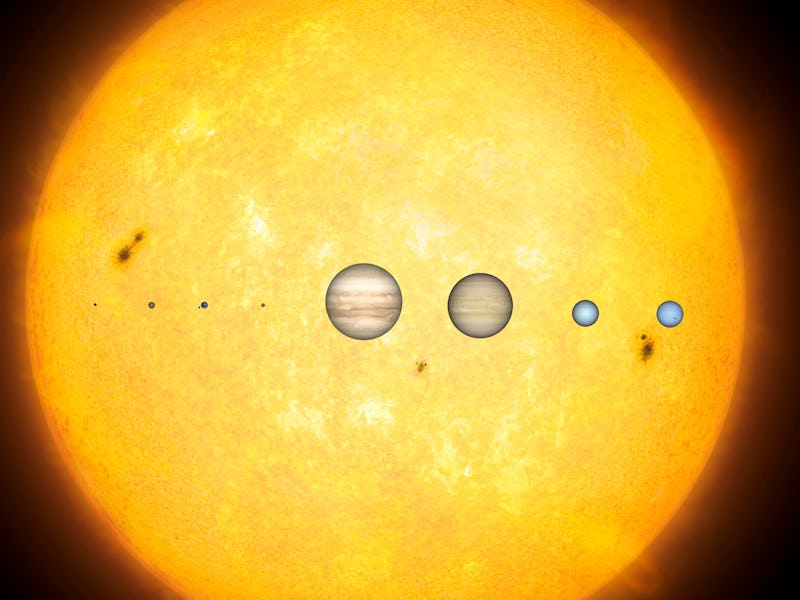Stunning new video reveals Solar Orbiter's view of Earth, Mars, and Venus
On its journey to the sun, the spacecraft has captured brilliant footage.

For nearly a year, a small spacecraft has been making its way toward the Sun in order to capture the closest images of our host star ever taken.
On its way to the Sun, the Solar Orbiter turned back to marvel at the beauty of three Solar System planets as they twinkled in the dark depths of space.
A new video reveals the spacecraft's view of Earth, Venus and Mars, capturing the three planets in the midst of their orbit around the Sun.
HERE'S THE BACKGROUND —The Solar Orbiter is a collaboration between NASA and the European Space Agency (ESA). Its mission aims to answer some of the unresolved, yet fundamental, questions scientists have about the Sun. What drives solar wind? How does the Sun’s magnetic field affect solar activity? And how does the star influence the Solar System, including our own planet?
It will take the spacecraft around two years to reach its target vantage point on Sun, using gravitational boosts resulting from flybys of Earth and Venus to make the journey.
On December 27, the Solar Orbit made its first cosmic stop at Venus, a brief flyby of the planet that will help it adjust its trajectory towards the Sun.
But while on its way to Venus, the spacecraft turned its cameras towards Earth, Venus and Mars as the three planets stood silently in the depths of space, surrounded by shimmering stars.
WHAT'S NEW — The video was captured on November 18, as the Solar Orbiter traveled closer to Venus.
In the video, Venus shines as the brightest planet and can be seen on the left, while Earth lies in the middle and Mars can be seen on the very right. From this perspective, we learn how small we really are compared to the vast cosmos.
As the closest planet to the Sun, Venus was approximately 48 million kilometers away from Solar Orbiter at the time that the video was taken, while Earth was 251 million kilometers and Mars was 332 million kilometers.
The three planets are surrounded by stars that are shinning in the background, and appear to be moving as the spacecraft flies through deep space.
The three planets also appear to be moving slightly, each in respect to the speed and motion of their orbit around the Sun. Venus takes 225 days to complete one orbit around the Sun, while the Earth takes 365 days and Mars takes 687 days.
The Sun, however, is not in frame.
WHAT'S NEXT — This is the first of many flybys of Venus, with the Solar Orbiter returning to the small planet every few orbits around the Sun in order to adjust its path. The Solar Orbiter’s next Venus flyby is scheduled for August, 2021.
Earlier in June, the spacecraft made its first close approach to the Sun, getting as close as 48 million miles to the star's surface, which is around half the distance between the Sun and the Earth.
By 2025, the Solar Orbiter will make its first pass by the Sun at 17 degrees of inclination, which will later increase to 33 degrees of inclination by the end of the decade. That will bring the Sun’s polar regions into direct view.
The Solar Orbiter is designed to take the most-accurate measurements yet of the Sun's solar wind, and capture a view of the Sun's magnetic poles from a high altitude for the very first time. To do that, it uses entirely new technology that will enable it to withstand the burning heat of the Sun.
The spacecraft carries 10 scientific instruments onboard. Six of them are remote sensing, capturing images of the Sun, while the remaining four are in-situ instruments, which will measure the surrounding environment around the spacecraft comprised of solar wind, plasma, and particles.
The Solar Orbiter will travel in an elliptical orbit around the Sun, completing one orbit every 168 days.
Ultimately, it will travel outside of the confines of the Solar System and peer down at the Sun, imaging the star from a high altitude. From its unique vantage point, the craft is set to capture the first images of the Sun’s polar regions, providing scientists with a better understanding of how the Sun’s magnetic field affects solar activity.
This article was originally published on